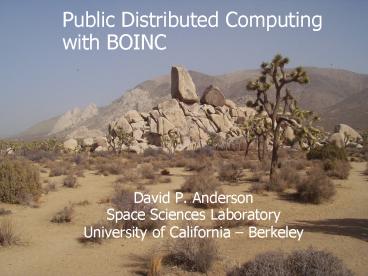David P. Anderson - PowerPoint PPT Presentation
1 / 15
Title:
David P. Anderson
Description:
Public Distributed Computing with BOINC David P. Anderson Space Sciences Laboratory University of California Berkeley Public-resource computing (cont.) 1 billion ... – PowerPoint PPT presentation
Number of Views:157
Avg rating:3.0/5.0
Title: David P. Anderson
1
Public Distributed Computing with BOINC
- David P. Anderson
- Space Sciences Laboratory
- University of California Berkeley
2
Public-resource computing
home PCs
your computers
academic
business
- Challenges
- low BW at client
- costly BW at server
- firewall/NAT issues
- sporadic connection
- untrustworthy, insecure clients
- server security
- heterogeneity
- need PR, glitzy GUI
- Advantages
- scale
- free
- growth
- public education
- no policy issues
3
Public-resource computing (cont.)
public computing
CPU power, storage capacity
Grid computing
cluster computing
supercomputing
cost
- 1 billion Internet-connected PCs in 2010
- 50 privately owned
- If 10 participate
- At least 100 PetaFLOPs, 1 Exabyte (1018) storage
p
4
SETI_at_home
- Running since May 1999
- 500,000 active participants
- 60 TeraFLOPs
- Problems with current software
- hard to change/add algorithms
- can't share participants w/ other projects
- inflexible data architecture
5
(No Transcript)
6
BOINC Berkeley Open Infrastructure for Network
Computing
- Goals for computing projects
- easy/cheap to create and operate DC projects
- wide range of applications possible
- no central authority
- Goals for participants
- easy to participate in multiple projects
- invisible use of disk, CPU, network
7
(No Transcript)
8
Data model
- Immutable files
- Replication across servers
- Can originate on clients or servers
- Can be retained on clients
- Computations can have multiple input and output
files - Applications can consist of multiple files
9
Computation model
- Redundant computing
work generation
assimilation
canonical result
validation
distribution
10
Computation model (cont.)
- Scheduling
- task resource estimates (disk/mem/CPU)
- soft deadlines
- Long-running tasks
- trickle messages, preemption
- API
- minimal (file I/O, checkpoint, graphics)
11
Participant features
- Can register with multiple projects, control
resource allocation - Preferences
- global, per-project
- edited via web interface
- Platforms Windows, Mac OS/X, Unix/Linux
- Anonymous platform mechanism
- Views
- GUI, screensaver, Windows service
12
Participant Credit
- Goals
- credit for work actually done (CPU, network,
storage) - don't know workunit size in advance
- cheat-proof
- Integration with redundancy
- claimed credit benchmark CPU time
- granted credit minimum claimed credit
- Handling graphics coprocessors
- project-specific benchmarks
13
Participant web features
- User profiles
- Forums
- Self-moderating FAQs
- Teams
- XML data export (3rd party statistics reporting)
14
Projects
- Current (at Space Sciences Lab)
- Astropulse (black hole / pulsar search)
- SETI_at_home
- In progress
- Folding_at_home (Stanford)
- Climateprediction.net (Oxford)
- Planned
- LIGO (physics)
- CERN
- DIMES (network performance study)
15
Summary and status
- Public distributed computing
- BOINC a platform for PDC
- BOINC is funded by NSF
- Source code is free for noncommercial use
http//boinc.berkeley.edu































